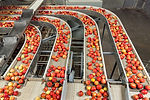Flow Wrappers
About flow wrappers
Flow wrappers come in horizontal and vertical orientations. Whilst they perform the same basic functions, there are some key differences.
Horizontal Form Fill Seal (HFFS) wraps items in a continuous sheet of film. They seal them along the top, bottom, and ends.
Rapid and accurate wrapping of products at high volumes - up to thousands per hour.
This method is popular for meats, fish, snacks, confectionery, and bakery goods.
Vertical Form Fill Seal (VFFS)
use a continuous roll of packaging film. They form it into a tube around the product, and then sealing the film both lengthwise and across the product.
This method creates airtight and moisture-proof packages. The machine utilises sensors and controllers to maintain accuracy and consistency.
VFFS flow wrappers handle products vertically and are generally more compact. They are suitable for a variety of products, including powders and liquids.
Some flow wrappers offer features like gas flushing to extend product freshness. Operated by either hot or cold sealing methods, they can include printing capabilities for dates and batch codes.
Key differences between Horizontal and Vertical flow wrappers
Orientation and Layout
-
HFFS (Horizontal Form Fill Seal)
-
Operates horizontally.
-
Products are placed on a conveyor belt, and the machine forms, fills, and seals the package from a roll of film.
-
Typically has a larger footprint due to its length, as it requires space for the conveyor and packaging process.
-

-
VFFS (Vertical Form Fill Seal)
-
Operates vertically.
-
The machine forms a bag from a roll of film, fills it with the product from above, and seals it, with one unit's sealing forming the base of the next.
-
Requires less floor space compared to HFFS due to its vertical orientation.
-

Suitability for Products
-
HFFS
-
Best suited for single solid items like bakery products, confectionary, or packs of meat or vegetables.
-
Suitable for packaging items that are already in a stable form and require a horizontal flow.
-
-
VFFS
-
Ideal for loose, granular, powdery, or liquid products like coffee, sugar, chips, and sauces.
-
Works well with products that are difficult to handle manually or require vertical filling.
-
Speed and Efficiency
-
HFFS
-
Generally faster in terms of packaging speed, capable of handling high-volume production efficiently.
-
Can pack a large number of products quickly, making it suitable for high-output needs.
-
-
VFFS
-
Slower compared to HFFS, with typical speeds of around 50-70 pouches per minute, though additional lanes can increase output.
-
More suitable for smaller to medium production volumes but can be scaled up with additional machinery.
-
Packaging Formats and Flexibility
-
HFFS
-
Offers greater variety in packaging types and closures, including pouches, cartons, and bags with zippers or nozzles.
-
Can accommodate a wide range of packaging formats and sizes.
-
-
VFFS
-
Typically produces bags or pouches with simple seals.
-
Limited to flexible packaging formats but can accommodate various bag sizes and styles.
-
Space Requirements
-
HFFS
-
Requires more floor space due to its horizontal conveyor system and longer machine length.
-
-
VFFS
-
More compact, occupying less floor space due to its vertical operation.
-
Key Questions to ask when looking for a used flow wrapper
If you are looking for a used flow wrapper, consider the following questions to help you select the right machine
What types of products will be packaged?
-
What is the size and shape or the product you are packing?
Do you have any space limitations?
-
Do you have enough room for a horizontal flow wrapper (they can be large) or do you need to look at a vertical flow wrapper?
What is the desired packaging speed?
-
How many bags per minute do you need to pack?
Do you need any extra features?
-
Features like Gas Flushing, MAP and Batch coding are not standard on all machines
What level of automation is required?
-
Do you need semi-automatic or fully automatic?
What is your budget?
-
Used flow wrappers can start in the low thousands and go upward from there, depending on age, condition, and the extra features it comes with.

























